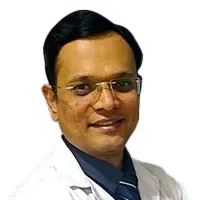Dr. Vidyadhara S, a dedicated Spine Surgeon at Manipal Hospitals, Bengaluru, brings over 22 years of experience and a wealth of expertise in spinal deformity surgeries and minimally invasive techniques. With over 1000 successful surgeries and numerous awards, he's earned recognition for his
academic achievements and contributions to spine surgery. Dr. Vidyadhara's proficiency in multiple languages fosters effective communication with patients, ensuring clarity and comfort throughout their treatment journey. Committed to excellence and innovation, he continues to advance the field through research, education, and compassionate patient care, solidifying his reputation as a leading spine surgeon in Bangalore.
Spinal Tumors : Abnormal growths of cells in the spinal canal, which can be cancerous (malignant) or noncancerous (benign). They can develop in the vertebrae, discs, nerves, or surrounding tissues. Symptoms vary depending on the tumor location and size, and can include pain, numbness, weakness, or difficulty walking. Treatment options depend on the tumor type, grade, and other factors, and may involve surgery, radiation therapy, chemotherapy, or a combination of these approaches.
Spinal Deformity : Abnormal curvatures of the spine, such as scoliosis (sideways curvature), kyphosis (excessive rounding of the upper back), or lordosis (excessive inward curvature of the lower back). These can be caused by congenital conditions, injuries, degenerative diseases, or other factors. Symptoms can vary but may include back pain, fatigue, uneven posture, or difficulty breathing in severe cases. Treatment depends on the severity and type of deformity, and may involve bracing, physical therapy, or surgery to correct the curvature and improve function.
Percutaneous Spine Intervention (Minimally Invasive) : A broad term encompassing various image-guided procedures that access the spine through small incisions for diagnosis and treatment. Techniques utilize needles, catheters, and specialized instruments to deliver medications, perform biopsies, or correct certain spinal problems. Compared to traditional open surgery, these procedures offer faster recovery, less blood loss, and smaller scars.
Endoscopic Spine Intervention : A specific type of percutaneous spine intervention that uses an endoscope (a thin, lighted instrument) to visualize and access the spine through small incisions. This allows for magnified views and precise manipulation of instruments for minimally invasive procedures like discectomy (removing herniated disc material) or vertebroplasty (injecting bone cement to strengthen vertebrae).
Disc Slip (Disc Herniation) : Occurs when the soft inner material (nucleus pulposus) of an intervertebral disc bulges or protrudes through a tear in the tough outer shell (annulus fibrosus). This can compress spinal nerves, causing pain, numbness, weakness, or tingling that radiates down the leg (sciatica) depending on the location of the herniated disc. Treatment options range from conservative measures like physical therapy and pain medication to surgical intervention (discectomy) to remove the herniated disc material.
Spinal Fusion : A surgical procedure to permanently connect two or more vertebrae in the spine. This is typically done to address instability, deformity, or pain caused by conditions like fractures, spinal stenosis (narrowing of the spinal canal), or degenerative disc disease. The surgeon uses bone grafts or implants to create a solid fusion between the vertebrae, limiting their movement and providing stability. Recovery from spinal fusion can be lengthy and involves physical therapy to regain strength and flexibility in the spine.













